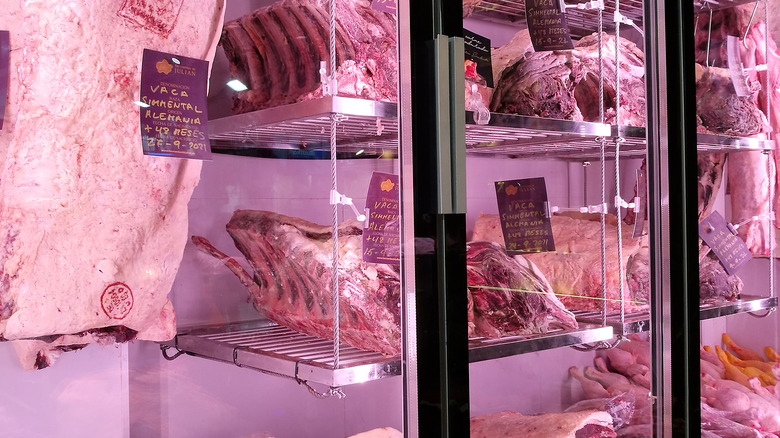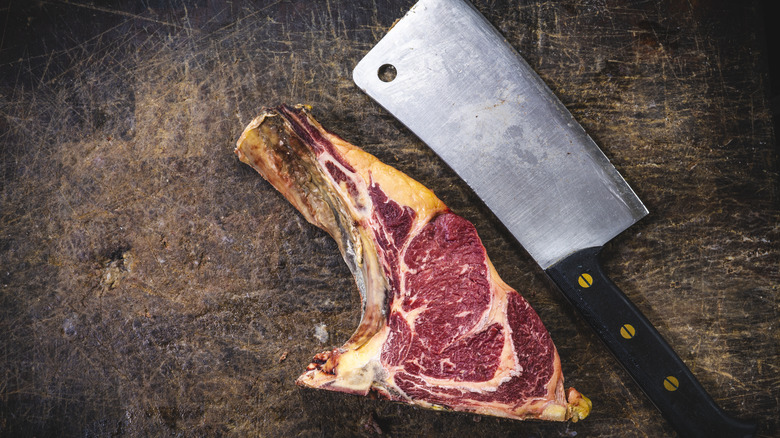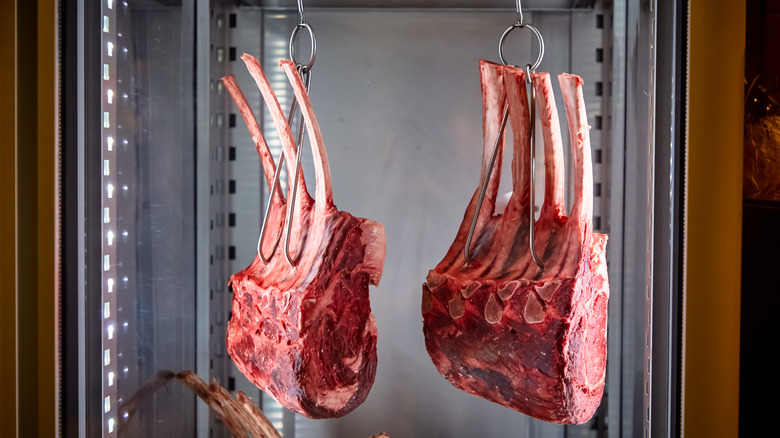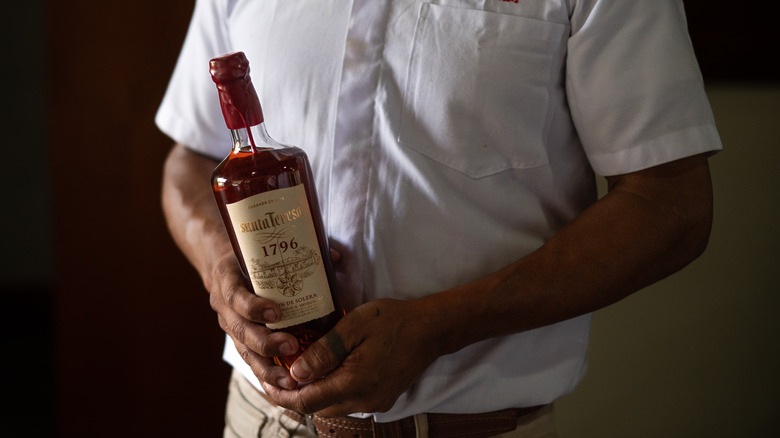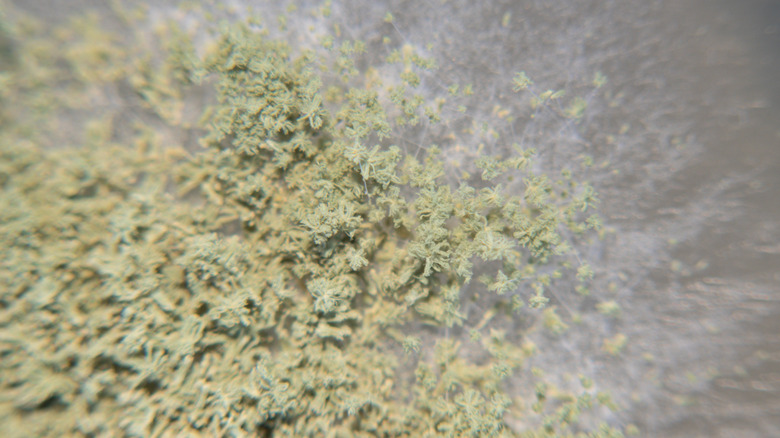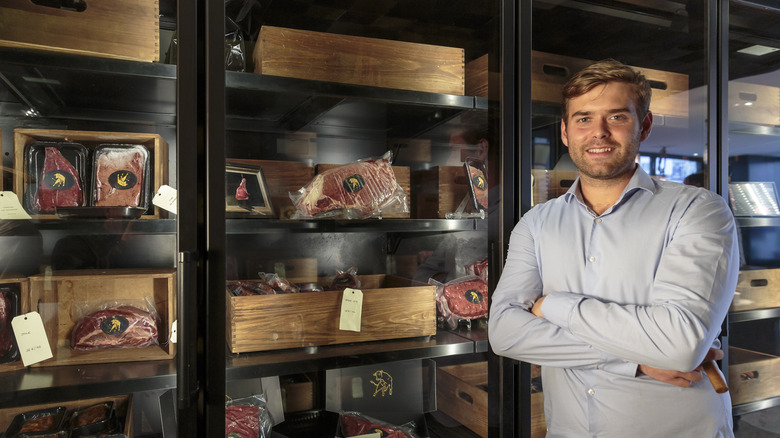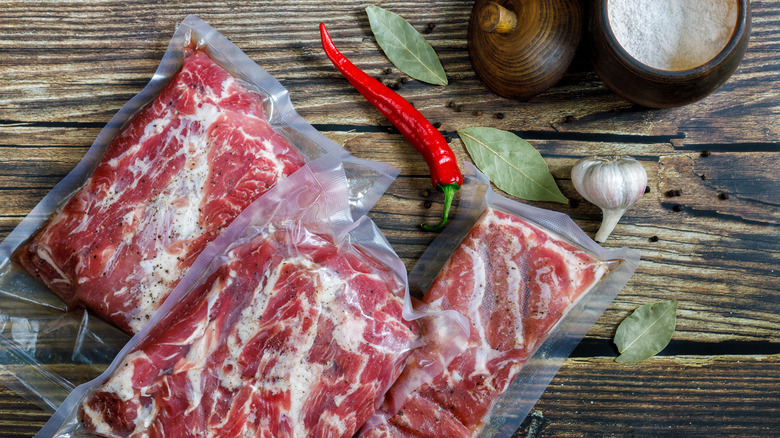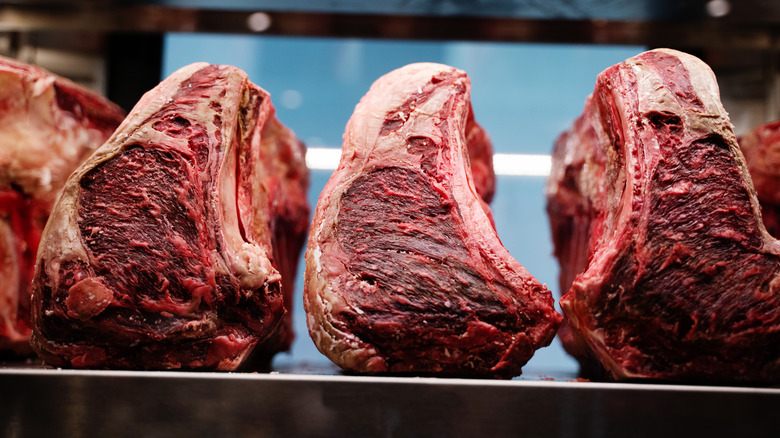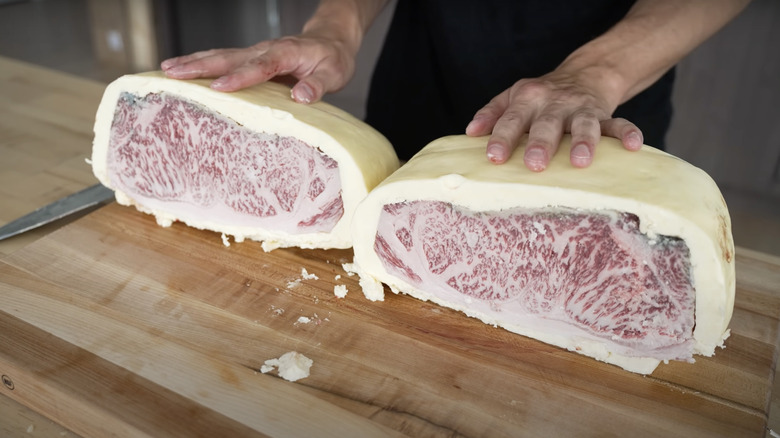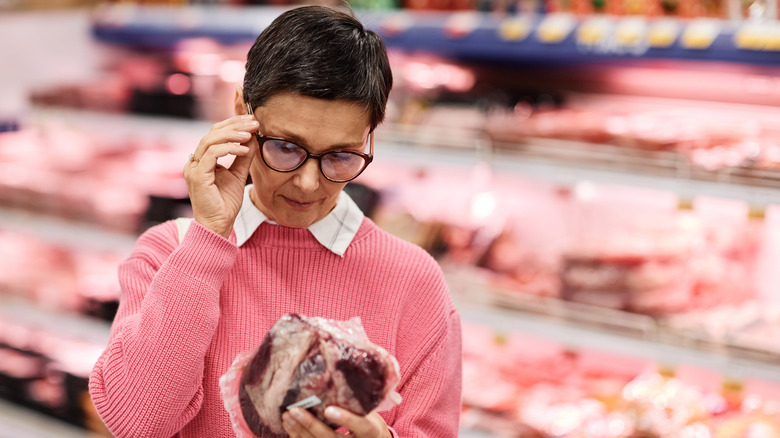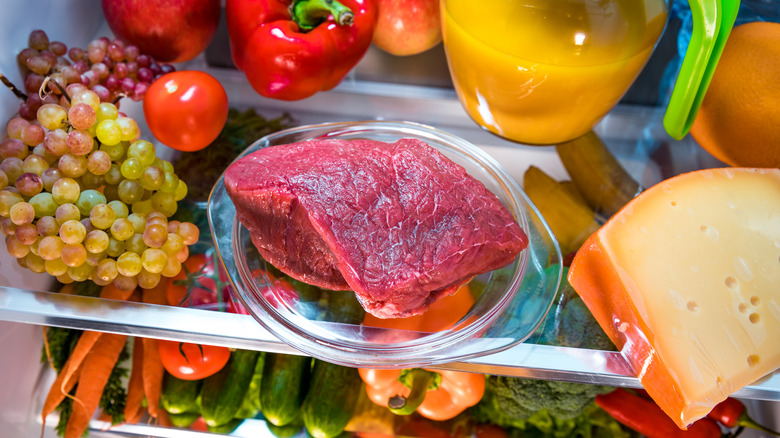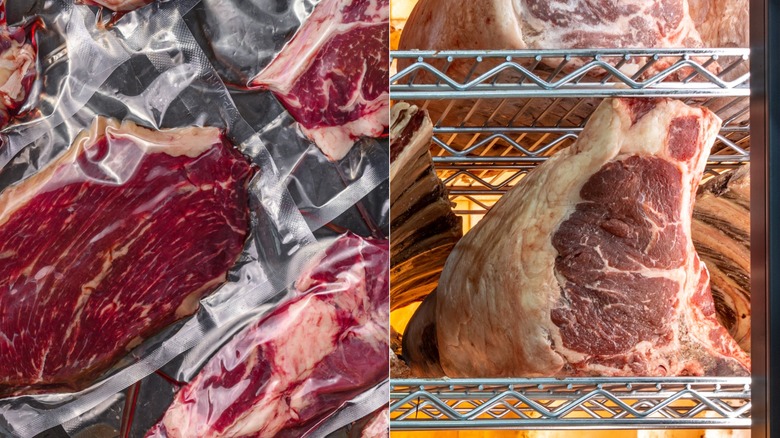Every Different Way To Age Steak, Explained By Chefs
If you frequent upscale steak houses, then chances are good that you'll have noticed some form of aged steak on the menu. You may have then wondered why it was so expensive and what methods chefs used to make it that way. For instance, you might head to Cote, a fashionable New York City Korean steakhouse, where you can order a dry-aged NY strip steak for $56 and a similarly aged ribeye for $58. Get an unaged version of either cut from the more run-of-the-mill, typically suburban Outback Steakhouse and they'll cost $28.99 and $31.99 respectively. The ambiance is not a sufficient explanation, though that certainly can help to raise prices. Instead, it's more about the meat itself.
But what's going on here? Some restaurant-goers who shy at the idea of shelling out big bucks for aged steak may not be fully aware of what the aging process entails. First, chefs and butchers choose the finest cuts from the healthiest, happiest animals. They then prepare those cuts of meat over an extended period of time that can take weeks to complete — or even longer. There are a variety of techniques they can choose from, too, meaning the taste of one aged steak can be very different from another.
Before you pull out your wallet to pay for this luxury item, it's smart to understand what you're getting on the plate. Then, with your knowledge, you can take the time to truly enjoy each forkful, knowing that the steak in front of you wasn't easy or fast to prepare. These are all the different ways to age steak, according to professional chefs.
What is aged steak?
Aging meat is a process that is almost exactly what it sounds like. When aging a cut, chefs and butchers leave the meat in a controlled environment to undergo changes that enhance its flavor and texture. However, the fact that many diners find this particularly desirable is a modern concept. Before refrigeration, livestock owners who lived in cooler climates butchered animals in the fall and left the carcasses hanging somewhere to be chilled by wintery weather. Sometimes they cured the meat, such as by making sausage. At other times they simply saved the meat in a cool, dry environment until it was needed. Foodborne illnesses were also a major issue, as pathogens could grow all too easily on the meat.
Once butchers could count on refrigeration, though, the meat industry blossomed. Now, slaughter could happen at any time of the year and meat packers could send massive amounts of product to grocery stores after hanging it for just 30 to 48 hours. In fact, their profit then and today depends on making this aging process as short as possible. The two-day hanging time remains a practice for modern producers because muscle tenses up the first day after slaughter, making the meat too hard to consume. Then, an enzyme called actomyosin starts to break down the muscle fibers in a cut and the meat becomes far more tender. That tenderness will increase the longer the product is left to sit on a rack, hang on a hook, or remain in a vacuum pack. According to regulations set by the USDA, meat sold as aged must have been allowed to relax for a minimum of 14 days.
Dry aging between two and four weeks
In dry aging, large cuts of meat hang from hooks or sit on special racks in a designated refrigerator or cold storage area. To get things just right, culinary experts obsessively control the airflow, humidity, and temperature, which should always be above freezing. Too low and the enzymatic changes stop. Too high, and you won't reduce the growth of harmful bacteria.
Large, fatty cuts of prime beef are best for aging. Chef Dean Harper, the founder of Harper Fine Dining, says that with a large enough cut "Time taken can allow the formation of a protective 'crust' (also called the bark) that protects the meat itself from spoilage and is removed later." Larger pieces of meat mean less gets wasted during trimming.
Executive chef Michael LeDuke of the Capital Grille line of steakhouses describes his aging process in detail: "The key to the dry age room is keeping it at 34-38 degrees and approximately 75% humidity." He says that he gets the best results when he ages beef between 18 and 28 days. Chef Joe Paish of Rolo's in New York employs a slightly lower temperature (34 degrees) and humidity (55% for the first three days, then 80%). He also highlights one of the main benefits of aging: "The water loss allows for a more beautiful sear and more even cookery."
Liquor dry aged meat
One of the most interesting ways to add a new dimension of flavor to steak is by dry aging it in liquor. Here, temperature and humidity are still carefully controlled, but chefs take a couple of additional steps to infuse the meat with the taste of whiskey, rum, wine, or another alcoholic beverage. Chef Michael Saperstein, owner of Sunshine Provisions, elaborates on his process: "The loin is wrapped in cheesecloth and sprayed with the liquor of choice. At Sunshine, we spray the loin one time per week. Popular liquors are whisky, dark rum, or other dark liquors with aromatic properties."
How meat takes on the characteristics of what surrounds it can be a blessing or curse. Meat easily absorbs the flavors of other pungent items nearby, so restaurants and supplies take steps to keep their meat lockers immaculate. It's a huge faux pas to age steaks in the same cooler as sausages, for example. According to Paish, "In the case of a restaurant or butcher with a dedicated dry aging cooler, this is generally not a problem — a clean, cold, dedicated aging fridge will generally not impart a funk to the product." This need for a large space for aging meat is one of the main reasons this dish is so expensive, too.
Dry aging with mold
Saperstein uses mold to add a distinctive taste to aged beef, lightly covering cuts "with white mold, a form of penicillin that is used for dry curing, or Aspergillus oryzae, also known as koji mold, and dried for 21-45 days." Penicillin gives sausage its white outer layer while koji grows on rice and imparts distinctive flavor to sake and soy sauce.
Chef Guy Meikle demonstrates the process of using koji on the YouTube channel The Chef's Roll. Meikle cuts a crisscross through the outer fat on a ribeye then smears the cut with koji paste. A couple of days later, he does the same on the bottom. Besides improving flavor, Meikle claims this speeds up the aging process so that, instead of storing meat for 45 days, his restaurant can move the same high-quality product after just 15 to 20.
Some even claim koji can age a steak to restaurant perfection in just 48 hours. To try it at home, grind up koji rice (you can order it online), rub it over a steak, and leave it in the fridge for a couple of days. Afterward, scrape the layer of koji off with a knife before pan-searing the meat.
Dry aging for longer than 30 days
Some butchers allow cuts of meat to age for much longer, to the tune of months or even years, though eating meat that's been stored for that long may not sound appetizing to newcomers. Meat expert Dana Ehrlich of Verde Farms and board member of the North American Meat Institute says "I've seen as long as 75 days in Australia [...] Mold also grows on the outside and needs to be cut off, so the flavor ends up becoming very concentrated (and very expensive)."
For most diners, having to cut a mold layer off meat may not sound appetizing, but some are fans. As Paish recalls, "I recently sampled a 110-day dry aged grass-fed beef shank and found it to be incredibly delicious."
French cattleman Alexandre Polmard is widely recognized as the champion of long steak aging. He has some steaks in storage that he's been waiting to eat (or sell at high prices) for over a decade. A single kilo of his meat can fetch more than $3,200. Polmard's secret is a two-step process. First, he dry ages beef. After around 50 days, he places it in a specially designed freezer where extra-cold air blows constantly. That means the ice crystals form differently than they do in a regular freezer. The final result is, to some, a fantastic steak.
Wet aging
Wet aging is the most common method of imparting a more tender texture to your meat. It means putting steaks in vacuum packs and then a refrigerator. Ehrlich says this aging process usually takes between 14 and 21 days and "typically won't have as dramatic an effect on the flavor as dry aging, though there is still a significant tenderization process involved." What you think of as the taste of meat, is, in fact, the taste of wet-aged beef. Most meat you buy in the grocery store has been wet-aged for some amount of time, although not always a full two weeks.
Aging meat this way has some huge benefits. Reduced food waste is a major one. Cutting the bark off of dry-aged meat when it's ready to consume means throwing out quite a bit. Wet-aged meat doesn't need any additional trimming. The cold storage where meat is kept in vacuum packs doesn't have to be exclusively for aging meat either. The plastic pack will keep most pathogens and funky flavors from getting to the meat. In other words, wet aging meat is a practical way to get beef to your table at the cheapest possible price.
Combination of dry and wet aging
Some chefs prefer using a combination of dry and wet aging and the result can be fantastic. Chef Dean Harper explains that when the two methods are used together, the dry hang usually lasts between a week and two. The period over which the meat ages in a vacuum pack can vary depending on the taste and texture a chef is after.
Executive butcher Tom Mylan wrote in The Atlantic that the best steak he ever tried was one aged this way. The animal had been 100% grass-fed. After slaughter, the carcass hung for two weeks. Then, the meat aged for a second two week period in a vacuum pack.
Apart from creating mouth-watering steaks, one of the biggest advantages to using this combination of aging styles is a reduction of moisture loss. While meat dry ages, a lot of water evaporates from it. This is one of the reasons it tastes so much meatier. On the other hand, chefs and butchers sell beef by the pound, and letting it dry for too long means it weighs significantly less. Putting meat in a vacuum at a certain point stops this loss of moisture, but the period spent dry aging adds flavor.
Tallow and butter aged meat
Coating a cut of meat in a layer of semi-solid fat such as tallow or butter before starting the aging process can bring some incredible benefits to the final product. That's because one of the biggest problems with dry aging is the loss of so much moisture and weight from a given cut of meat over the lengthy aging process. Adding a layer of fat around a cut before leaving it to age not only helps retain water but also adds flavor.
Saperstein explains his tallow aging method: "The loin is dipped in liquid tallow until thoroughly coated. This produces a very beefy concentrated flavor profile." Other animal fats can produce slightly different flavors. For example, chef William Eick of Matsu points out that covering meat in duck fat before aging creates delicious results with distinct flavors.
Chef Nick DiGiovanni walks viewers through his process of butter aging on YouTube. He takes a smaller cut of meat than what's traditionally used in dry aging — just 10 pounds of wagyu. He whips up homemade butter and covers the cut with a 3/4-inch layer, wearing gloves to prevent the butter or meat from becoming contaminated. Then, he leaves it to age for 60 days. When cut open, there is only a thin bark on the exterior of the meat.
Understanding the labels on aged meat and menus
Labels can be confusing and the ones on aged beef are no exception. Any time a package says that the meat inside has been aged, it must specify the method and for how long the cut was aged, as per the USDA. Additionally, meat sellers must have aged the product for at least 14 days. On the other hand, if the label says that a cut was dry aged, it doesn't have to specify how many days the meat was subject to the process. However, vacuum packaging cannot have played a role. Neither is there a minimum number of days required for this label, although the agency's Food Standards and Labeling Policy Book states that the process usually takes between 10 days and six weeks.
Generally, however, you can rely on some careful reading. According to Paish, "If meat has been dry aged, it will be declared boldly on the signage, packaging, or menu — one simply does not undertake the expense and effort of dry aging in secret." Moreover, if spendy additions like liquor, butter, or koji have helped the aging process along, menus and labels will likely trumpet that fact, too.
If places don't tout their process in detail, it could mean they're trying to exaggerate. Likewise, you won't see many labels declaring that a cut has been wet-aged because most commercial meat goes through this process.
Can you age steak at home?
Though it may be tough to hear, the reality is that you should not attempt to dry age steak at home unless you plan to make a significant investment. Aging steak requires a specific environment and specialized knowledge that most homes and amateur cooks just don't have, not to mention seriously expensive equipment and large amounts of meat that could be difficult to store.
Wet aging doesn't prove as problematic, though. "People can age meat at home if they buy vacuum-sealed beef, but it's typically not necessary as it has already been sufficiently wet aged prior to purchase. Dry aging is risky at home without a proper setup," says Ehrlich. Trying to dry age meat in your everyday refrigerator would mean exposing it to all of the funky smells and potential pathogens that live there. In comparison, commercial meat aging setups have very strict disinfecting schedules and specialized equipment.
Which method of aging meat is the best?
Each method of aging meat will appeal to different people. This is a matter of personal taste and so there is no correct answer. Many consumers prefer the flavor of wet-aged beef because it tastes familiar. Dry aged cuts have a far more intense beefy flavor and often have notes of blue cheese due to the mold that sometimes grows on the bark.
From a practical point of view, wet aging is superior to dry in that it allows for more flexibility. Restaurants don't need exclusive cold storage only for aging steaks, and neither do determined home cooks. Dry aging, on the other hand, is more of an art and can be tremendously poetic from a culinary point of view. If you're feeling truly curious about which is better, you probably have some delicious dinners to look forward to. Have fun taste-testing aged meat at steakhouses near you until you discover one perfect flavor you love more than the others.
